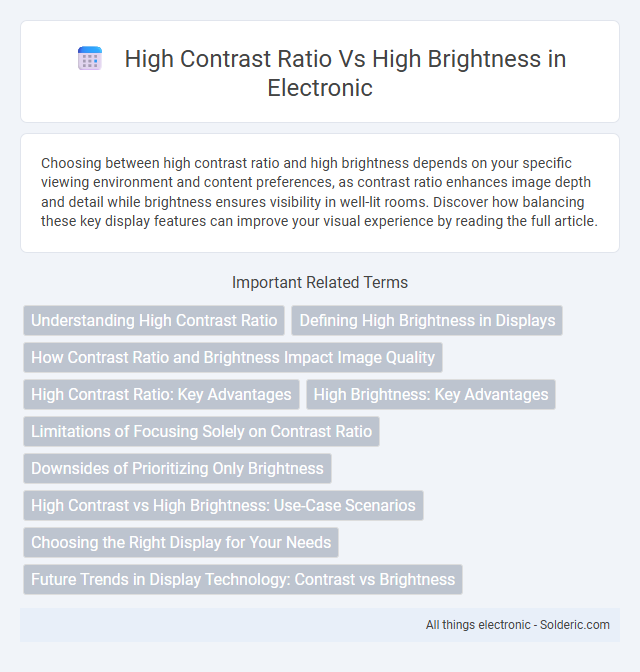Choosing between high contrast ratio and high brightness depends on your specific viewing environment and content preferences, as contrast ratio enhances image depth and detail while brightness ensures visibility in well-lit rooms. Discover how balancing these key display features can improve your visual experience by reading the full article.
Comparison Table
| Feature | High Contrast Ratio | High Brightness |
|---|---|---|
| Definition | Ratio between darkest black and brightest white | Maximum luminance level displayed by screen (measured in nits) |
| Purpose | Enhances detail and depth in images | Improves visibility in bright environments |
| Best For | Dark scenes, movies, photography | Outdoor use, HDR content, well-lit rooms |
| Visual Impact | Richer blacks, sharper image contrast | Brighter visuals, clearer highlights |
| Measurement | Expressed as a ratio (e.g., 1000:1) | Measured in candela per square meter (cd/m2 or nits) |
| Trade-offs | May reduce screen brightness to maintain deep blacks | Can cause glare and higher power usage |
Understanding High Contrast Ratio
High contrast ratio refers to the difference between the darkest black and the brightest white a display can produce, significantly impacting image clarity and detail in dark scenes. A higher contrast ratio enhances visual depth, making your screen content more vivid and easier to discern under various lighting conditions. Understanding high contrast ratios helps you select displays that offer richer colors and sharper images, especially important for media consumption and professional graphic work.
Defining High Brightness in Displays
High brightness in displays refers to the luminance level measured in nits, indicating how much light a screen emits to ensure visibility in various lighting conditions. Higher brightness values, typically above 600 nits, enable clear viewing even in direct sunlight or brightly lit environments. Your choice of display brightness directly impacts the clarity and legibility of images and text, especially when contrasted with the display's contrast ratio.
How Contrast Ratio and Brightness Impact Image Quality
High contrast ratio enhances image quality by producing deeper blacks and more vivid colors, which improves detail in dark scenes and overall picture clarity. High brightness ensures images remain visible and vibrant in well-lit environments, reducing glare and maintaining color accuracy. Balancing both contrast ratio and brightness allows your display to deliver sharp, clear visuals with rich detail regardless of ambient lighting conditions.
High Contrast Ratio: Key Advantages
High contrast ratio enhances image depth by producing deeper blacks and more vibrant colors, significantly improving visual clarity and detail in both dark and bright scenes. This advantage is critical for applications such as home theaters and professional photo editing, where color accuracy and sharpness are paramount. High contrast ratio also reduces eye strain by providing clearer differentiation between light and dark elements on the screen.
High Brightness: Key Advantages
High brightness in displays enhances visibility in well-lit environments, ensuring clear and vibrant screen content even under direct sunlight. It improves user experience by reducing eye strain and enabling readability without the need for acoustic dimming or additional lighting. High brightness is crucial for outdoor devices, professional monitors, and audiovisual setups requiring vivid image clarity and accurate color reproduction.
Limitations of Focusing Solely on Contrast Ratio
Focusing solely on high contrast ratio limits display performance understanding, as it neglects the essential role of high brightness in ensuring visibility under various lighting conditions, especially in well-lit environments. High brightness enhances image clarity and color vibrancy, which contrast ratio alone cannot guarantee since a high contrast ratio with low brightness may result in dull or washed-out visuals. Optimal display quality requires balancing both high contrast ratio and high brightness to deliver sharp, vivid images across diverse viewing scenarios.
Downsides of Prioritizing Only Brightness
Focusing solely on high brightness in displays can lead to washed-out images and reduced color accuracy, diminishing overall viewing quality. High contrast ratio is essential to achieve deeper blacks and richer colors, enhancing image detail and depth that brightness alone cannot provide. Your visual experience may suffer if brightness is prioritized without balancing contrast, resulting in less vibrant and lifelike visuals.
High Contrast vs High Brightness: Use-Case Scenarios
High contrast ratio enhances image depth and detail, making it ideal for watching movies or editing photos where differentiation between dark and light areas is crucial. High brightness is essential in brightly lit environments or outdoor settings to ensure screen visibility and reduce glare. Your choice depends on whether you prioritize vivid visuals in controlled lighting or clear visibility under strong ambient light conditions.
Choosing the Right Display for Your Needs
High contrast ratio enhances image depth by producing darker blacks and more vivid colors, while high brightness improves visibility in well-lit environments. You should prioritize high contrast ratio for cinematic experiences or professional photo editing, as it ensures richer detail and color accuracy. For outdoor use or bright rooms, selecting a display with greater brightness guarantees clearer images and better readability.
Future Trends in Display Technology: Contrast vs Brightness
Future display technology trends emphasize enhancing high contrast ratio to deliver deeper blacks and richer colors, crucial for immersive visual experiences in OLED and microLED panels. Concurrently, advancements in high brightness, particularly in mini-LED and Quantum Dot displays, are driving superior visibility in bright environments and HDR performance. Balancing contrast and brightness remains pivotal as manufacturers innovate to optimize dynamic range and color accuracy across diverse lighting conditions.
High Contrast Ratio vs High Brightness Infographic

 solderic.com
solderic.com